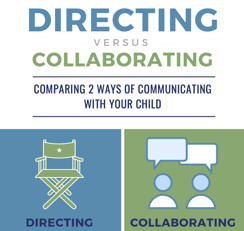Picture this - you just finished your second Zoom meeting of the day. Your daughter is in the kitchen attending school remotely. She is a bright kid, but tends to be get distracted and off track during her remote classes. You walk into the kitchen to refill your coffee, but really your objective is to check in on her. As you walk in, she frantically closes a couple tabs on her computer. You ask what she is doing and your daughter replies with one-word answers. Your instincts tell you to leave her alone - but at the same time, you worry that she's falling behind. So, you decide to work in the kitchen to keep closer tabs on what she is doing. Every so often you ask to see what she is working on, or comment and offer suggestions. She ignores it all. Once classes end, she goes back up to her room where she stays for the majority of the remaining day - just as she had yesterday and the day before.
daughter is in the kitchen attending school remotely. She is a bright kid, but tends to be get distracted and off track during her remote classes. You walk into the kitchen to refill your coffee, but really your objective is to check in on her. As you walk in, she frantically closes a couple tabs on her computer. You ask what she is doing and your daughter replies with one-word answers. Your instincts tell you to leave her alone - but at the same time, you worry that she's falling behind. So, you decide to work in the kitchen to keep closer tabs on what she is doing. Every so often you ask to see what she is working on, or comment and offer suggestions. She ignores it all. Once classes end, she goes back up to her room where she stays for the majority of the remaining day - just as she had yesterday and the day before.
For too many parents, this scenario may seem vividly familiar. Remote and hybrid learning have presented challenges to students' Executive Function skills that make it tough to navigate smoothly on their own. But what happens when you know your kid isn't putting in the effort they need to?
This is the question I find most parents I work with asking: How can I find a middle ground between allowing my kids to continue their bad habits unchecked and playing the role of helicopter parent?
Let’s face it, COVID has compounded this problem just by the simple fact that we are all at home now more than ever. In my almost 18 years in education as a school psychologist, and later as an administrator, I've spoken with hundreds of parents who are worried about their kids - and who worry about how much oversight to provide their children.
When considering options, it's important to remember one thing: whether it's a teacher, parent, boss, or even spouse, no one likes having someone looking over their shoulder. For most, it creates additional pressure - especially when you're already stressed. And worst of all, it's unpleasant for the person doing the hovering, too. So how does one be involved without being over-involved? Here are my top 4 tips to help you find that ideal balance:
Tip #1: Communication is key
Have a conversation with your teen or young adult. Don’t lecture, don’t argue - have a calm conversation. Try to speak as if you are having a conversation as what to watch on Netflix or what to make for dinner - something that is usually conflict free. Keep this in mind, teens and young adults are always looking to prove that they are responsible, grown up, and don’t need someone telling them what they have to do. So this is a time to let them prove themselves. Stress how you want to help them become more independent with their school assignments and other responsibilities. For example, you can say, “I know you don’t like it when I check on your progress with school. So, I am going to take a step back and let you handle school for a while.” Now, you have to realize that you will need to be patient with this. Sometimes, you have to let someone struggle before they learn to do it on their own.
Tip #2: Assistance is still available upon request
Just because you are not hovering does not mean that you can’t help when they ask. Emphasize that you are there for them whenever they need you. For example, you could say something like: “Think of me as a resource, if you ever want some help.” Asking for help is one of the best lessons that we can teach our children. I always tell parents their child needs to learn to self-advocate; it's a necessary skill for both students and adults.
Tip #3: Silence is sometimes a test
Recognize your child may or may not communicate with you about their school work. This is normal and part of the process. Most likely your child is testing you to see if you are really committed to not hovering. If they don’t talk to you and you begin asking questions about getting their work done or needing any help, it shows a lack of trust. They feel that you are not allowing them to show that they have grown, rather you are just hovering in a slightly different way. This breaks the trust on your agreement not to hover. You are going to have to resist the urge - but you are strong and can do it!
Tip #4: Engagement is still necessary
Wait! I did not imply that you shouldn't talk about school at all. Please continue to show your interest in their day and their life as parents do. Just resist the urge to ask about specific assignments or school work. You can definitely ask questions such as: What was the best part of your day? Did you have any funny moments on Zoom? What made you feel happiest today? If your child says that they thought you were taking a step back, you simply reaffirm that you are but you still are interested in their world -and that you are there if they want to share anything with you. This keeps you consistent with your initial conversation and your availability to them.
Practicing less hovering now when your child is learning remotely (or in a hybrid environment) will be challenging. By doing so now, you will be a pro when your child has resumed in-person learning in a post-COVID world. It's time to practice relinquishing control. Wouldn’t it be wonderful to increase your child’s independence when it comes to school work and homework? Above all, remember that you have the best of intentions and that your child’s progress and growth are your goal. Let's help them on the journey, but not get in the way. Better for them, better for you - everyone wins!
Photo above by Windows on Unsplash
 Laura Thoresen is an Executive Function Coach and Coaching Coordinator with Beyond BookSmart. Laura has a full educational career as a certified School Psychologist, Principal, and Director of Special Services. She has nearly 20 years experience working with students in both special education and general education peers. Laura graduated from Fairleigh Dickinson University with a Bachelors and Masters and received her NJ State certificate as a School Psychologist. As a lifetime learner, Laura attended and graduated from Caldwell College where she received a Masters in Educational Supervision and Administration. She later received her NJ State certificate as a Principal.
Laura Thoresen is an Executive Function Coach and Coaching Coordinator with Beyond BookSmart. Laura has a full educational career as a certified School Psychologist, Principal, and Director of Special Services. She has nearly 20 years experience working with students in both special education and general education peers. Laura graduated from Fairleigh Dickinson University with a Bachelors and Masters and received her NJ State certificate as a School Psychologist. As a lifetime learner, Laura attended and graduated from Caldwell College where she received a Masters in Educational Supervision and Administration. She later received her NJ State certificate as a Principal.
Download our infographic to learn how to communicate more collaboratively with your child, while also building their independence and self awareness.


